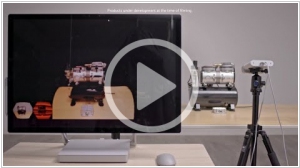Kinect for Enterprise
Updated: August 01, 2023
Kinect for Enterprise is a commercial version of the Kinect sensor technology developed by Microsoft, tailored specifically for business and industrial applications. Originally designed for gaming and motion-based interactions on Xbox consoles, Kinect for Enterprise extends its capabilities to provide advanced motion tracking, gesture recognition, and depth sensing functionalities for various business use cases. This technology enables hands-free and natural interactions with computers, devices, and applications, offering a more immersive and intuitive user experience. In enterprise settings, Kinect can be integrated into training simulations, virtual reality experiences, healthcare applications, and interactive presentations, among other applications. Its potential for enabling gesture-based control and data visualization opens up new possibilities for improving productivity, creativity, and engagement across different industries and enterprise environments.
See also: Top 10 Public Cloud Platforms
See also: Top 10 Public Cloud Platforms
2019. Microsoft unveiled Kinect for enterprise
In a surprising move back in 2015, Microsoft unexpectedly discontinued Kinect, the 3D camera designed for the XBOX game console. At that time, it appeared that the company believed people had already exhausted their interest in this intriguing device. However, Microsoft has now come up with a new concept: why not extend its use to businesses? This led to the introduction of Azure Kinect. Priced at $399, Azure Kinect remains the same 3D camera, but now it is integrated with a cloud platform that enables the creation and execution of diverse business applications. The processing of videos from Kinect is more straightforward compared to traditional cameras. For instance, there is a toolkit available that generates a spatial model, capturing movements of individuals within that space. Consequently, Kinect can be employed for purposes such as monitoring the performance of new employees, implementing automated surveillance in retail stores, or tracking patients within a hospital setting, among other potential applications.
2012. Who needs Kinect for business?
Today Microsoft has launched Kinect for Windows with the Kinect SDK for developers. It means that now it's possible to develop any application for Kinect, which will run on any PC. And it's not done for people who want to save money on buying the XBox console (it wouldn't be clever from Microsoft's side). The reason is that the company sees much more opportunities for using this motion and voice sensor besides games and entertainments. So where Kinect could be used in the business world? Microsoft identifies the three main industries: healthcare, education and retail. ***
2011. Microsoft Dynamics AX 2012 adds cloud services

MBS President, Kirill Tatarinov (at the left) plays with Dynamics AX 2012 via Kinect ***
2011. Kinect + GMail Motion : use gestures to manage your inbox
On April 1st, Google playfully introduced a new feature called GMail Motion. It claimed to enable users to control emails and input text in the GMail mailbox through gestures (as demonstrated in a video). However, not everyone grasped the humor behind it. A group of individuals from Southern California University took this concept seriously and transformed it into a reality by connecting a Kinect device to GMail using a plugin. Here's an explanation of how the technology functions:




